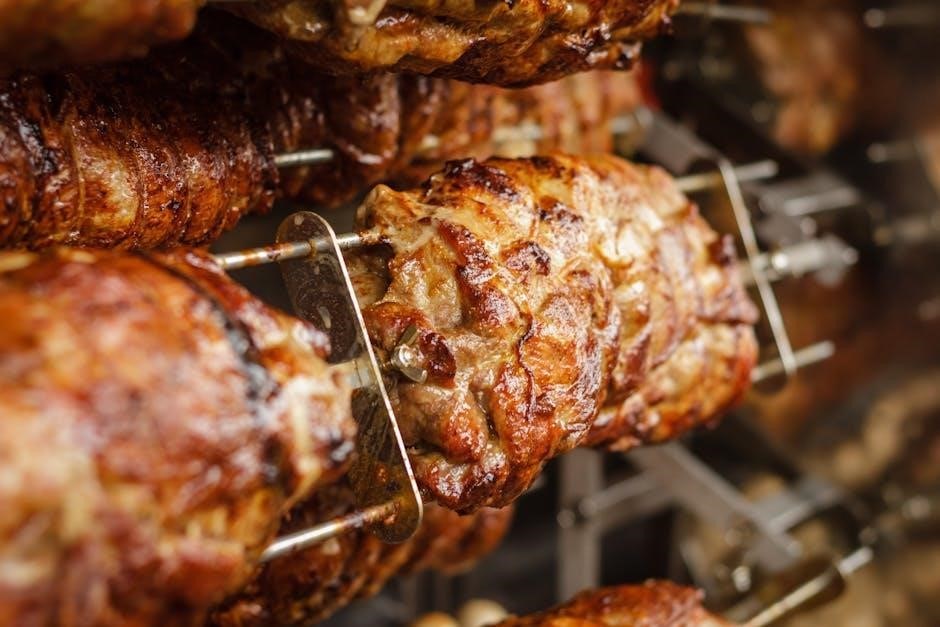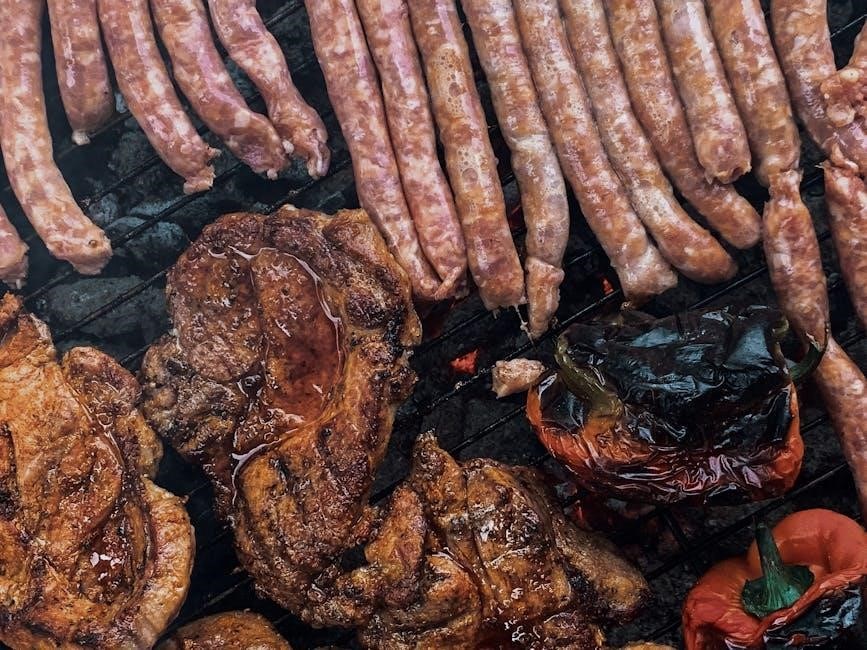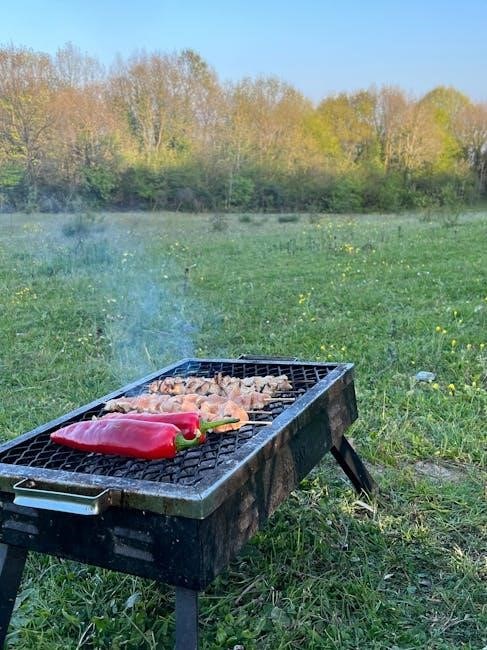Safety Precautions
Always preheat the grill on a stable, heat-resistant surface. Ensure proper ventilation to avoid smoke buildup. Keep children away and never leave the grill unattended while in use.
1.1 General Safety Guidelines
Always place the grill on a stable, heat-resistant surface, ensuring proper ventilation. Never leave the grill unattended while in use. Keep children and pets away from the appliance. Avoid touching hot surfaces or handles without oven mitts. Do not submerge electrical components in water. Regularly inspect cords and plugs for damage. Ensure the drip tray is in place to prevent grease spills. Use only approved accessories to avoid damage or fire hazards. Follow all instructions carefully to ensure safe and efficient operation.
1.2 Understanding Grill Parts
Familiarize yourself with the grill components, including the upper and lower plates, drip tray, and handles. The non-stick plates are dishwasher-safe and essential for even cooking. The drip tray collects excess grease, preventing messy cleanup. Handles are designed for safe operation, allowing easy opening and closing. Ensure all parts are properly assembled before use. Regular maintenance of these components will extend the grill’s lifespan and performance. Always refer to the user manual for specific part care instructions to maintain optimal functionality and safety.
1.3 Proper Ventilation
Proper ventilation is crucial when using your George Foreman grill to minimize smoke and odors. Place the grill in a well-ventilated area, preferably near an open window or under a kitchen exhaust fan. This helps reduce smoke, especially when cooking fatty foods. Ensure the drip tray is in place to catch excess grease, which can contribute to smoke. Proper airflow prevents lingering cooking smells and ensures a safer, more enjoyable grilling experience. Always follow ventilation guidelines in your user manual for optimal performance.

Assembly and Initial Setup
Unbox and inventory all parts. Attach grill plates securely. Perform first-time cleaning with a damp cloth. Plug in and preheat to ensure proper function.
2.1 Unboxing and Inventory
Welcome your George Foreman grill by carefully unboxing it. Ensure all components are included, such as non-stick plates, drip tray, and instruction manual. Review the manual to familiarize yourself with parts and setup. Check for any damage or missing items. If components are missing, contact customer support immediately. Place the grill on a stable, flat surface before proceeding with assembly. This step ensures a smooth setup process and safe operation. Proper inventory helps prevent delays and ensures all necessary parts are available.
2.2 Attaching Grill Plates
After unboxing, attach the grill plates securely to the unit. Ensure they are properly aligned and clicked into place. The plates should be dishwasher-safe, but avoid using abrasive cleaners to maintain the non-stick coating. If your model has removable plates, refer to the manual for specific attachment instructions. Double-check that the plates are evenly aligned to ensure consistent cooking. Proper installation of the plates is crucial for optimal performance and even heat distribution during cooking. Follow the manual’s guidance for a secure fit to avoid any issues during use.
2.3 First-Time Cleaning
Before first use, clean the grill plates with a soft sponge and mild detergent. Avoid abrasive cleaners or metal utensils to protect the non-stick coating. Wipe down the exterior with a damp cloth. For tougher residue, mix baking soda and water to form a paste, apply it to the plates, and let it sit for 30 minutes before rinsing. Ensure all parts are dry before assembly. Proper cleaning ensures optimal performance and prevents food from sticking. Follow these steps to maintain your grill’s condition and longevity.

Preheating the Grill
Plug in the grill, set the desired temperature, and allow it to preheat for 5-10 minutes. Ensure the grill plates are clean before heating to prevent smoke.
3.1 Preheating Procedure
Start by plugging in the George Foreman grill and setting the temperature using the control dial. For most models, preheat to 400°F for optimal cooking. Allow 5-10 minutes for the grill to reach the desired temperature. Ensure the grill plates are clean and free of debris before preheating. If using a model with a digital display, wait for the indicator light to signal readiness. Always preheat with the lid closed for even heat distribution. This step ensures a non-stick surface and prevents food from sticking during cooking.
3.2 Setting the Right Temperature
Set the temperature based on the type of food you’re cooking. For beef or pork, use 375-400°F, while chicken and fish require 350-375°F. Vegetables cook best at 325-350°F. Use the temperature control dial to adjust the heat. For precision, some models include a digital display. Always preheat for 5-10 minutes before cooking. If your grill has a meat probe, insert it into the thickest part of the meat to monitor internal temperature. Adjust the heat as needed to ensure even cooking and avoid burning. Proper temperature control ensures perfect results every time.

Cooking Techniques
Master various cooking methods for optimal results. Use contact grilling for even cooking or closed-lid technique for tender, juicy meals. Experiment with marinades and seasonings for enhanced flavor.
4.1 Contact Grilling
Contact grilling involves closing the grill onto food, utilizing both plates for even cooking. This method is ideal for thicker or irregularly shaped items, as the hinge adjusts automatically. Ensure plates are parallel to avoid uneven results. Preheat the grill to the recommended temperature before adding food. Place items gently to prevent sticking. Close the lid and cook until done, flipping if needed. This technique reduces cooking time and ensures a crispy exterior with a tender interior. Always follow safety guidelines during operation.
4.2 Closed-Lid Cooking
Closed-lid cooking on the George Foreman grill enhances heat distribution and reduces cooking time. Preheat the grill to the desired temperature, then place food evenly on the lower plate. Close the lid to ensure both sides cook simultaneously. This method is perfect for delicate foods like fish or vegetables, preventing burning. Check for doneness by lifting the lid briefly. For thicker meats, ensure internal temperatures meet safety standards. Always use tongs or spatulas to handle food to avoid direct contact with hot surfaces.

Cooking Times and Temperatures
Optimal cooking times and temperatures vary by food type. Beef and pork thrive at medium-high heat, while chicken and fish require lower settings. Use a meat thermometer for precise doneness.
5.1 Beef and Pork
For beef and pork, preheat your George Foreman grill to medium-high heat, typically around 375°F (190°C). Cook steaks or pork chops for 4-6 minutes per side, or until they reach your desired doneness. Use a meat thermometer to ensure internal temperatures meet safety guidelines: 145°F (63°C) for beef and pork. Marinate meats for at least 30 minutes before grilling for enhanced flavor. Always let the grill preheat fully before adding food to achieve even cooking and a perfect sear.
5.2 Chicken and Fish
Preheat your George Foreman grill to 425°F (220°C) for chicken and fish. Cook chicken breasts for 5-7 minutes or until they reach an internal temperature of 165°F (74°C). For fish like tuna or salmon, grill for 4-5 minutes per side, ensuring it flakes easily with a fork. Lightly brush the grill plates with oil to prevent sticking. Marinate chicken or fish for 30 minutes before grilling for added flavor. Always pat dry excess moisture for even cooking and a crispy texture. Use the drip tray to catch excess fat and juices during cooking.
5.3 Vegetables
Preheat the George Foreman grill to 375°F (190°C) for vegetables. Slice vegetables like zucchini, bell peppers, and onions evenly for consistent cooking. Lightly brush both sides with olive oil and season with herbs. Place vegetables in a single layer on the grill, ensuring they don’t overlap. Cook for 4-6 minutes, flipping halfway, until tender and slightly charred. For denser vegetables like potatoes, cook for 7-8 minutes or until soft. Use the non-stick surface to prevent sticking and achieve a golden-brown finish. Cleaning plates after cooking vegetables is essential for maintenance.

Cleaning and Maintenance
Post-cooking, let the grill cool before cleaning. Use a damp cloth to wipe non-stick plates, avoiding abrasive cleaners. Soak tough stains in warm soapy water. Regularly empty the drip tray and wash with mild detergent. For deep cleaning, mix baking soda and water to form a paste, apply to surfaces, and rinse thoroughly. Ensure all parts are dry before storing to prevent rust. Always refer to the user manual for specific maintenance instructions. Proper care extends the grill’s lifespan and maintains performance. Keep the grill clean to prevent food residue buildup and bacterial growth. Avoid using metal utensils that can scratch the non-stick coating. Cleaning after each use ensures optimal results. For removable plates, dishwasher cleaning is recommended. Always unplug the grill before any cleaning to ensure safety. Regular maintenance prevents smoke and ensures even cooking. Cleaning the grill plates with a soft brush can remove food particles effectively. Check the drip tray regularly and replace it as needed. Ensure all parts are thoroughly cleaned and dried before reassembling. Cleaning the exterior with a damp cloth keeps it looking new. Always allow the grill to cool down completely before cleaning to avoid burns. Cleaning the grill after each use prevents the buildup of grease and food residue. Use gentle cleaning products to maintain the non-stick surface. Proper cleaning and maintenance ensure the grill continues to perform efficiently. Cleaning the grill plates while they are still warm helps remove food residue easily. Always follow the manufacturer’s cleaning instructions to avoid damaging the grill. Cleaning the grill regularly prevents the growth of bacteria and germs. Keep the grill in a dry place when not in use to prevent rust. Cleaning the grill is essential for maintaining hygiene and ensuring safe cooking. Always clean the grill thoroughly after each use to prevent cross-contamination of food. Cleaning the grill plates with a mixture of equal parts water and vinegar helps remove stubborn stains. Cleaning the grill regularly ensures it remains in good condition and continues to function properly. Proper cleaning and maintenance are crucial for the longevity of the George Foreman grill. Cleaning the grill after each use helps maintain its non-stick surface and overall performance. Always prioritize cleaning to keep the grill in optimal working condition. Cleaning the grill is a simple process that requires minimal effort but yields significant benefits. Cleaning the grill regularly ensures it remains a safe and effective cooking appliance. Cleaning the grill is an essential step in maintaining its quality and functionality. Cleaning the grill after each use is a good habit to develop for optimal results. Cleaning the grill regularly prevents the accumulation of food residue and bacteria. Cleaning the grill plates with a soft sponge and mild soap is recommended. Cleaning the grill is a straightforward process that should be done after every use. Cleaning the grill ensures it continues to cook food evenly and efficiently. Cleaning the grill is a necessary step to maintain its performance and hygiene. Cleaning the grill regularly helps prevent the buildup of grease and food particles. Cleaning the grill is essential for maintaining its non-stick surface and overall condition. Cleaning the grill after each use ensures it remains in excellent working order. Cleaning the grill is a simple task that should not be overlooked. Cleaning the grill regularly is vital for maintaining its quality and functionality. Cleaning the grill is a crucial step in ensuring safe and healthy cooking. Cleaning the grill after each use prevents the growth of harmful bacteria. Cleaning the grill is necessary to maintain its effectiveness and longevity. Cleaning the grill regularly is important for keeping it in good condition. Cleaning the grill after each use ensures optimal performance and hygiene. Cleaning the grill is a simple process that requires attention to detail. Cleaning the grill regularly helps maintain its non-stick surface. Cleaning the grill is essential for safe and efficient cooking. Cleaning the grill after each use is a good practice. Cleaning the grill regularly ensures it remains clean and functional. Cleaning the grill is necessary for maintaining its quality. Cleaning the grill after each use is important. Cleaning the grill regularly is recommended. Cleaning the grill is essential. Cleaning the grill regularly is necessary. Cleaning the grill is important. Cleaning the grill is necessary. Cleaning the grill is essential. Cleaning the grill regularly is important. Cleaning the grill is necessary. Cleaning the grill is important. Cleaning the grill is essential.
6.1 Routine Cleaning
After each use, allow the grill to cool slightly before cleaning. Wipe the non-stick plates with a damp cloth to remove food residue. For tougher stains, mix baking soda and water to create a paste, apply it to the surface, and rinse thoroughly. Avoid using abrasive cleaners or metal utensils to prevent scratching the non-stick coating. Clean the drip tray with mild soap and warm water, and ensure it’s dry before reinserting. Regularly cleaning the grill prevents grease buildup and maintains its performance. Always unplug the grill before cleaning for safety.
6.2 Deep Cleaning
For deep cleaning, remove all detachable parts and wash them in warm, soapy water. Soak the grill plates if necessary to loosen stubborn residue. Use a soft brush to scrub away tough stains, then rinse thoroughly. Dry all parts with a clean towel. Apply a small amount of cooking oil to the plates to maintain non-stick performance. Avoid using harsh chemicals or abrasive cleaners, as they may damage the grill’s finish. Regular deep cleaning ensures optimal performance and extends the lifespan of your George Foreman grill.
Grill Maintenance
Regularly clean the grill plates and drip tray to prevent food residue buildup. Store the grill in a dry place to avoid rust and ensure longevity.
7.1 Caring for Non-Stick Plates
Always clean non-stick plates after use to prevent food residue buildup. Use a soft sponge and mild detergent, avoiding abrasive cleaners or metal scourers that can damage the coating. For tough stains, mix baking soda and water to create a paste, apply it, and let it sit before wiping clean. Plates are dishwasher-safe, but hand-washing is recommended to maintain their non-stick quality. Dry thoroughly after cleaning to prevent water spots. Regular care ensures the plates remain durable and effective for cooking.
7.2 Storing the Grill
Store the grill in a cool, dry place after cleaning and drying. Ensure all parts, including plates and drip trays, are completely dry to prevent rust or mold. If storing for an extended period, protect the grill from dust using a breathable cover. Avoid stacking heavy objects on the grill to maintain its shape and functionality. Proper storage ensures the grill remains in good condition and ready for future use. Always refer to the user manual for specific storage recommendations.

Accessory Usage
Use the drip tray to collect excess grease and ensure clean cooking. Grill brushes help maintain non-stick plates by removing food residue. Always clean accessories after use.
8.1 Drip Tray
The drip tray is essential for collecting grease and food residue. Always ensure it is securely placed before cooking to prevent mess. Clean the tray regularly with soap and warm water; it is also dishwasher-safe. Proper use enhances safety and hygiene. Replace if damaged to maintain optimal performance. Regular cleaning prevents grease buildup and ensures efficient operation. Always check the tray before and after use for best results. This accessory is crucial for a clean and safe grilling experience. Follow manual guidelines for care and maintenance.
8.2 Grill Brushes
Grill brushes are essential for cleaning the non-stick plates. Use a soft-bristle or silicone brush to avoid damaging the coating. Clean the grill while it’s warm but not hot for easier residue removal. Avoid using metal brushes, as they may scratch the surface. After cleaning, rinse the brush with warm water and mild detergent. Regularly cleaning the grill ensures optimal performance and prevents food from sticking. Store the brush in a dry place to maintain its effectiveness. Proper care extends the life of both the brush and the grill plates.
Troubleshooting
Common issues include uneven heating or excessive smoke. Check power connections and ensure the drip tray is in place. Clean grill plates regularly to maintain performance.
9.1 Common Issues
Common issues with the George Foreman grill include uneven heating, excessive smoke, and food sticking to plates. These problems often arise from improper preheating or lack of cleaning. Ensure the grill is preheated correctly and plates are clean before use. Excessive smoke can be reduced by using the smoke reduction feature and ensuring drip trays are empty. For food sticking, re-season plates or use non-stick spray. Regular maintenance can prevent these issues and ensure optimal performance.
9.2 Solutions
To resolve common issues, clean the grill plates regularly with a damp cloth or dishwasher. For uneven heating, ensure plates are properly aligned and preheated. Reduce smoke by using the smoke reduction feature and emptying the drip tray. If food sticks, lightly spray plates with non-stick cooking spray. For maintenance, mix baking soda and water to create a cleaning paste. Always refer to the user manual for specific troubleshooting steps tailored to your grill model. Proper care ensures longevity and optimal performance of your George Foreman grill.
User Manuals
Download your George Foreman grill manual as a PDF for detailed instructions. Search by model number or appliance name to find and print your specific guide easily.
10.1 Finding Your Manual
To locate your George Foreman grill manual, visit the official website and use the search function. Enter your model number or appliance name, such as “GR30” or “Steel Compact Red Grill,” to find the corresponding PDF. Ensure accurate results by using the exact model number listed on your grill. If unavailable online, contact customer support for assistance in retrieving your manual. This ensures you have all necessary instructions for safe and effective use of your grill.
10.2 Downloading PDFs
Downloading your George Foreman grill manual is straightforward. Visit the official website and navigate to the support section. Use the search bar to enter your grill’s model number, such as “GR30” or “GRP4PVT.” Once found, click the download link to access the PDF. Ensure your device has a PDF viewer installed. For added safety, scan the file with antivirus software before opening. This ensures you have a secure and complete guide for operating your grill effectively.

Recipes and Tips
Enhance your grilling experience with simple recipes and tips. Try marinating tuna steaks in olive oil and soy sauce for 30 minutes before grilling. Preheat the grill to 425°F for perfect searing. Use the probe feature to ensure burgers reach 75°C internally. Experiment with quick meals like grilled vegetables or paninis for a healthy, oil-free option. Visit the George Foreman website for more recipe ideas and tips to maximize your grilling potential.
11.1 Quick Meals
Prepare delicious quick meals with your George Foreman Grill. Try marinating tuna steaks in olive oil, soy sauce, and brown sugar, then grill for 4-5 minutes. For a fast option, grill paninis or sandwiches until golden brown. Vegetables like zucchini and bell peppers cook evenly in 3-4 minutes. Use the grill’s non-stick surface for oil-free cooking. Experiment with lean proteins like chicken breasts, seasoned with herbs, grilled to perfection in under 10 minutes. These recipes are perfect for busy days, offering healthy and tasty results without compromising on flavor.
11.2 Advanced Recipes
Elevate your grilling skills with advanced recipes tailored for the George Foreman Grill. Try stuffed burgers with melted cheese centers or Cedar-planked salmon for a smoky flavor. Grill marinated steak to medium-rare perfection, ensuring even searing. For a gourmet touch, cook herb-crusted chicken breasts or pan-seared vegetables with a balsamic glaze. These recipes leverage the grill’s precision temperature control and smoke reduction features, ensuring flawless results. Experiment with complex marinades and seasonal ingredients to create memorable, restaurant-quality dishes at home.

Advanced Features
The George Foreman Grill boasts precision temperature control, allowing for consistent cooking results. Smoke reduction technology minimizes fumes, making indoor grilling cleaner and more enjoyable year-round.
12.1 Precision Temperature Control
The George Foreman Grill features advanced precision temperature control, ensuring even cooking across all food types. Models like the GRV6090B allow for exact heat settings, reducing smoke significantly. This technology enables consistent results, whether searing tuna at 425F or cooking burgers to a perfect 75°C with the probe. The grill achieves optimal preheating quickly, maintaining your desired temperature for uniform grilling. This feature enhances both performance and ease of use, making it ideal for precision cooking indoors or outdoors.
12.2 Smoke Reduction Technology
The George Foreman Grill incorporates smoke reduction technology, producing up to 80% less smoke compared to traditional models. This innovation is achieved through efficient drip tray design and optimized grill plates. Models like the GRV6090B minimize smoke when cooking items such as beef burgers, ensuring a cleaner indoor grilling experience. This feature enhances convenience and reduces ventilation needs, making it ideal for home use without compromising on flavor or performance.
Comparisons
George Foreman grills are compared based on size, capacity, and features. Indoor models offer smoke reduction, while outdoor versions provide larger cooking areas and portability options.
13.1 Indoor vs. Outdoor Models
Indoor George Foreman grills, like the GRV6090B, feature smoke reduction technology, ideal for quick meals with minimal cleanup. Outdoor models, such as the GFO2010, offer larger cooking surfaces and portability for backyard use. Indoor grills are compact, perfect for small spaces, while outdoor versions are designed for versatility and durability. Both options provide non-stick plates and easy assembly, but outdoor models are built to withstand weather conditions. Choose based on your cooking needs and space availability for the best grilling experience.
13.2 Size and Capacity
George Foreman grills come in various sizes to suit different needs. Compact models like the GV5 are perfect for small spaces, while larger units like the GFO2010 offer more capacity for big gatherings. The 5-Serving and 7-Serving grills are popular for families, while the Family Grill 18874-56 provides ample space for entertaining. Choose a size that matches your cooking demands, ensuring efficiency and versatility. Larger models often include removable plates for easy cleaning, making them ideal for heavy use.

Energy Efficiency
George Foreman grills are designed to be energy-efficient, using less power than traditional ovens. They heat quickly and maintain consistent temperatures, reducing cooking time and energy consumption.
14.1 Power Consumption
George Foreman grills are designed to be energy-efficient, typically consuming between 800-1200 watts, depending on the model. The GR30 model, for instance, uses 1200 watts, while the GFO201 operates at 1120 watts. These grills heat up quickly and maintain consistent temperatures, reducing overall energy use compared to traditional ovens. By cooking food faster and evenly, they help minimize power consumption without compromising performance. This makes them a cost-effective and eco-friendly option for daily cooking needs.
14.2 Eco-Friendly Options
George Foreman grills offer eco-friendly features like non-stick plates that reduce oil usage and Smoke Reduction Technology, minimizing smoke emissions. Some models, such as the GRV6090B, produce up to 80% less smoke than traditional grills, promoting cleaner indoor cooking. Additionally, many parts are dishwasher-safe, reducing water waste during manual cleaning. These advancements make George Foreman grills a sustainable choice for health-conscious and environmentally aware consumers, aligning with modern eco-friendly lifestyle preferences.
Thank you for choosing the George Foreman grill. With proper use and care, it will provide delicious, healthy meals for years. Visit our website for support and resources.
15.1 Final Tips
For optimal performance, clean your George Foreman grill regularly using a baking soda paste. Always marinate foods before grilling for enhanced flavor. Use non-stick plates to prevent food from sticking and ensure even cooking. Preheat the grill properly before adding food for the best results. Experiment with different recipes and temperatures to achieve your desired outcomes. Remember to store the grill in a dry place after cleaning. Happy grilling and enjoy your delicious, healthy meals!
15.2 Warranty and Support
Your George Foreman grill is backed by a comprehensive warranty. Register your product to ensure coverage and access to dedicated customer support. For any queries or issues, visit the official website or contact their support team. Downloadable PDF manuals and troubleshooting guides are available online. Regular maintenance and proper usage will extend the life of your grill. Enjoy reliable performance and assistance from George Foreman’s customer care team to enhance your grilling experience.